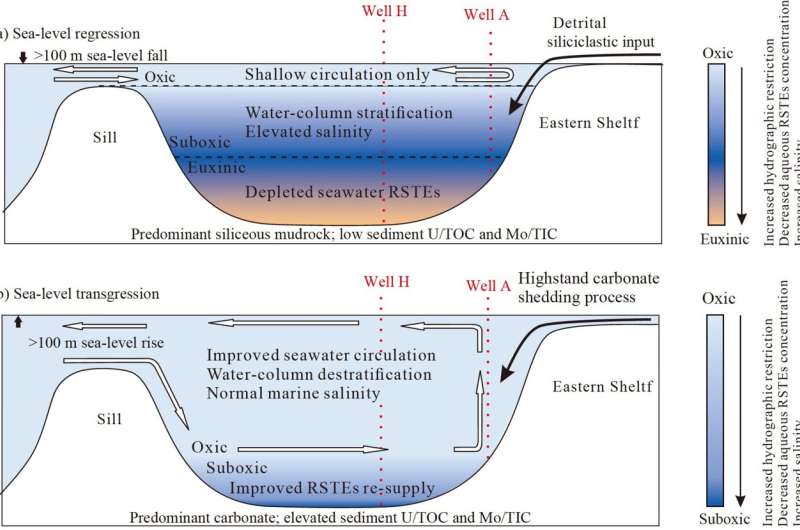(a) Sea-level regression resulted in highly restricted hydrographic circulation, increased salinity, depleted seawater RSTE, low sediment Mo/TOC and U/TOC, stably stratified water column and euxinic bottom water, and predominant siliceous mudrock deposition. (b) Sea-level transgression resulted in improved deep-water renewal, normal marine salinity, resupply of seawater RSTE, elevated sediment Mo/TOC and U/TOC, destratification of the water column and oxic-suboxic bottom water, and deposition of carbonate. Well H, Horwood 2151H; Well A, Adoue 1H. Credit: Science China Press
A recent study, published in Science China Earth Sciences, was led by Dr. Junwen Peng (Bureau of Economic Geology, Jackson School of Geosciences, The University of Texas at Austin). Based on thousands of high-resolution elemental composition datasets, Dr. Junwen Peng found that the overall variation ranges of RSTE (especially Mo and U) concentrations largely overlap among sediments deposited from a wide redox spectrum (from oxic to euxinic conditions) in the Cline Shale, restricted Midland Basin, U.S. This finding is, however, contradictory with the traditional theory that RSTE is generally enriched in sediments that deposited from more reducing environments.
To figure out this contradictory phenomenon, Dr. Peng reconstructs the benthic redox history and seawater circulation model in the restricted Midland Basin within the sequence stratigraphic framework of the Cline Shale. The results suggest that in contrast to the sediment RSTE enrichment patterns, the variations of sediment Mo/TOC and U/TOC ratios (indicators of seawater Mo and U concentrations, respectively) are coupled with glacio-eustatic fluctuation. The highest Mo/TOC and U/TOC ratios are commonly observed in sediments deposited during the highest relative sea-level (RSTE resupply), whereas the lowest Mo/TOC and U/TOC ratios usually appear in sediments deposited during the lowest relative sea-level (RSTE depletion). The depletion of seawater RSTE during the lowest relative sea-level caused subsequent low sediment RSTE content in euxinic conditions.
Dr. Peng's findings imply that the benthic redox conditions recorded in sediment Mo and U concentrations can be greatly obscured and weakened by local seawater chemistry (i.e., seawater Mo and U concentrations) and sea-level variations in highly restricted basins. Thus, the use of sediment Mo and U concentrations as redox proxies in these highly restricted basins should be tested and calibrated with other redox proxies. The current situation that RSTE was widely used as paleo-redox proxies in different geological contexts (e.g., lacustrine environment) is indeed worthy of attention and re-evaluation.
More information: Junwen Peng, What besides redox conditions? Impact of sea-level fluctuations on redox-sensitive trace-element enrichment patterns in marine sediments, Science China Earth Sciences (2022). DOI: 10.1007/s11430-021-9959-8
Journal information: Science China Earth Sciences
Provided by Science China Press
























